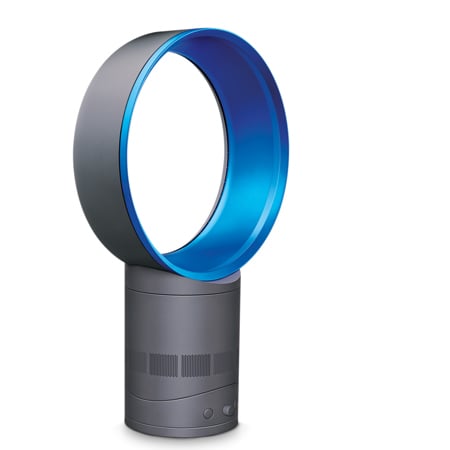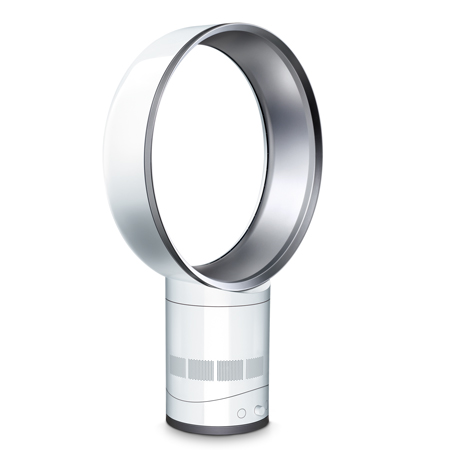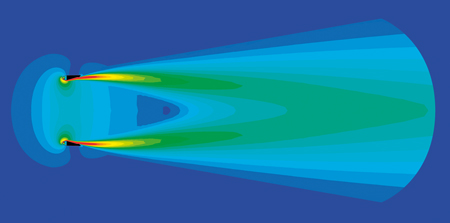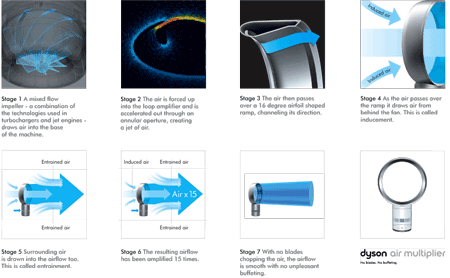
Air Multiplier by Dyson
Industrial designer James Dyson has launched a fan with no blades.

The motor is positioned in the product's base.

Air is passed through a ring-shaped aperture in the rim of the top section and travels through the loop over an aerofoil.

Click for larger image
The fan produces an even flow of air, controlled by a continuous dimmer switch.
Watch a movie about the design here.
Here's some more information from Dyson:
--
Say goodbye to the blade
No blades. No buffeting.
Chop, chop. The blades on conventional electric fans literally chop the air, which means the airflow is uneven, causing unpleasant buffeting.
The Dyson Air Multiplier™ fan has no blades. Instead it uses Air Multiplier™ technology to amplify air 15 times, expelling 405 litres of cool, smooth and uninterrupted air every second.
Air is accelerated through an annular aperture set within the loop amplifier. This creates a jet of air which passes over an airfoil-shaped ramp that channels its direction. Surrounding air is drawn into the airflow (this is called inducement and entrainment).
Dyson’s fluid dynamics engineers ran hundreds of simulations to measure and map airflow – allowing them to precisely optimise how the Dyson Air Multiplier™ fan works.
The Dyson Air Multiplier™ fan is powered by an efficient brushless motor and air speed can be precisely adjusted with dimmer-switch control. Fans with blades are only wired to run at just two or three settings.
No blades means no need for a grille; so it’s safe and simple to clean.
And because its motor is at its base, the Dyson Air Multiplier™ fan can be tilted with a touch, unlike a conventional top-heavy fan, which needs to be positioned with two hands and can topple easily.
James Dyson says
“I’ve always been disappointed by fans. Their spinning blades chop up the airflow, causing annoying buffeting. They’re hard to clean. And children always want to poke their fingers through the grille. So we’ve developed a new type of fan that doesn’t use blades.”
Dyson Air Multiplier™ fan: the facts
No buffeting
The blades on conventional fans cause unpleasant buffeting because they chop the air. Air Multiplier™ technology gives an uninterrupted stream of air that doesn’t distract or buffet you.
Hygienic
With its simple loop the Dyson Air Multiplier™ fan is quickly wiped clean with a cloth. Fans with blades are nigh on impossible to clean, with dust and dirt building up inside the cage. The same dust and dirt is then billowed into your face when the fan is switched on.
Stable
Unlike top-heavy conventional fans, the Dyson Air Multiplier™ fan has an energy-efficient motor is at its base, meaning it has a low centre of gravity and doesn’t topple over.
Touch-tilt
You have to use two hands to position a fan with blades. The Dyson Air Multiplier™ fan adjusts easily with a touch of the hand. It pivots on its low centre of gravity and stays put.
Variable airflow
Fans with blades have limited settings. The Dyson Air Multiplier™ fan uses an energy-efficient brushless motor, which means air speed can be precisely adjusted up or down. The airflow control switch control allows people to pick their perfect airflow.
Oscillation control
To oscillate a conventional fan you have to hold it steady, pull the toggle and watch it judder. Oscillating the Dyson Air Multiplier™ fan through 90º is simple. Press the button.
Strong
The Dyson Air Multiplier™ fan is constructed from tough Acrylontride butadiene styrene – ABS (C8H8 C4H6 C3H3N)n). ABS is a tough thermoplastic used to make light, rigid and moulded products. It has shock absorbing properties and is used to make car bumpers, crash helmets and modern golf club heads. It’s used in Dyson vacuum cleaners and Dyson Airblade™ hand dryers too.